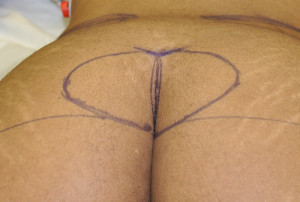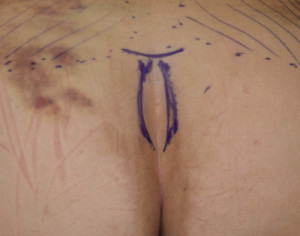Buttock augmentation has become a procedure today that almost rivals that in public interest and in procedures performed like that of breast augmentation. By far the most common method of buttock augmentation uses the patient’s own fat as an injectable technique known as the Brazilian Butt Lift. (BBL) But not everyone is a candidate for a BBL due to either lack of fat for adequate injectable volume or has been through a BBL procedure where the fat has not adequately survived.
Buttock implants offers a method of buttock augmentation that exerts its effect by the placement of a non-degradable solid silicone implant. While it is a far more invasive procedure and has a longer recovery, it offers a permanent buttock size increase.
The biggest ‘controversy’ in buttock implants is the pocket location as to whether it is on top of the muscle (subfascial) or inside the gluteus muscle. (intramuscular) This decision has great relevance for options in implant size and the risk of long-term complications. Intramuscular buttock implants permit only smaller implant sizes but have a better long-term prognosis and lifespan. Subfascial buttock implants permit much larger sizes but has a potentially higher rate complications. (e.g.,s seroma, implant visibility)
One controversy of buttock implants that is less written about or addressed is that of the incision used to place them. All buttock implants are placed through an intergluteal incision that should stay below the superior end of the crease to remain hidden. When one considers that the most common complication of buttock implants, regardless of pocket location, is wound dehiscence or incisional separation, how the incision is made and closed has considerable merit. While usually a self-healing problem, an intergluteal incision can take a long time to heal and potentially exposes the implants to contamination and risk of infection.
The intergluteal incision for buttock implants can be placed as a single midline technique or a double parallel off midline incisional technique. Each has their own advantages and disadvantages.


Both the single and double intergluteal incision techniques can be used very successfully in buttock implants. Both seem to scar well and neither in my experience has necessitated scar revision due to their healed appearances. But I tend to favor the double incision technique as it has less risk of postoperative wound dehiscence problems which makea a patient’s recovery quicker and less problematic.
Dr. Barry Eppley
Indianapolis, Indiana


